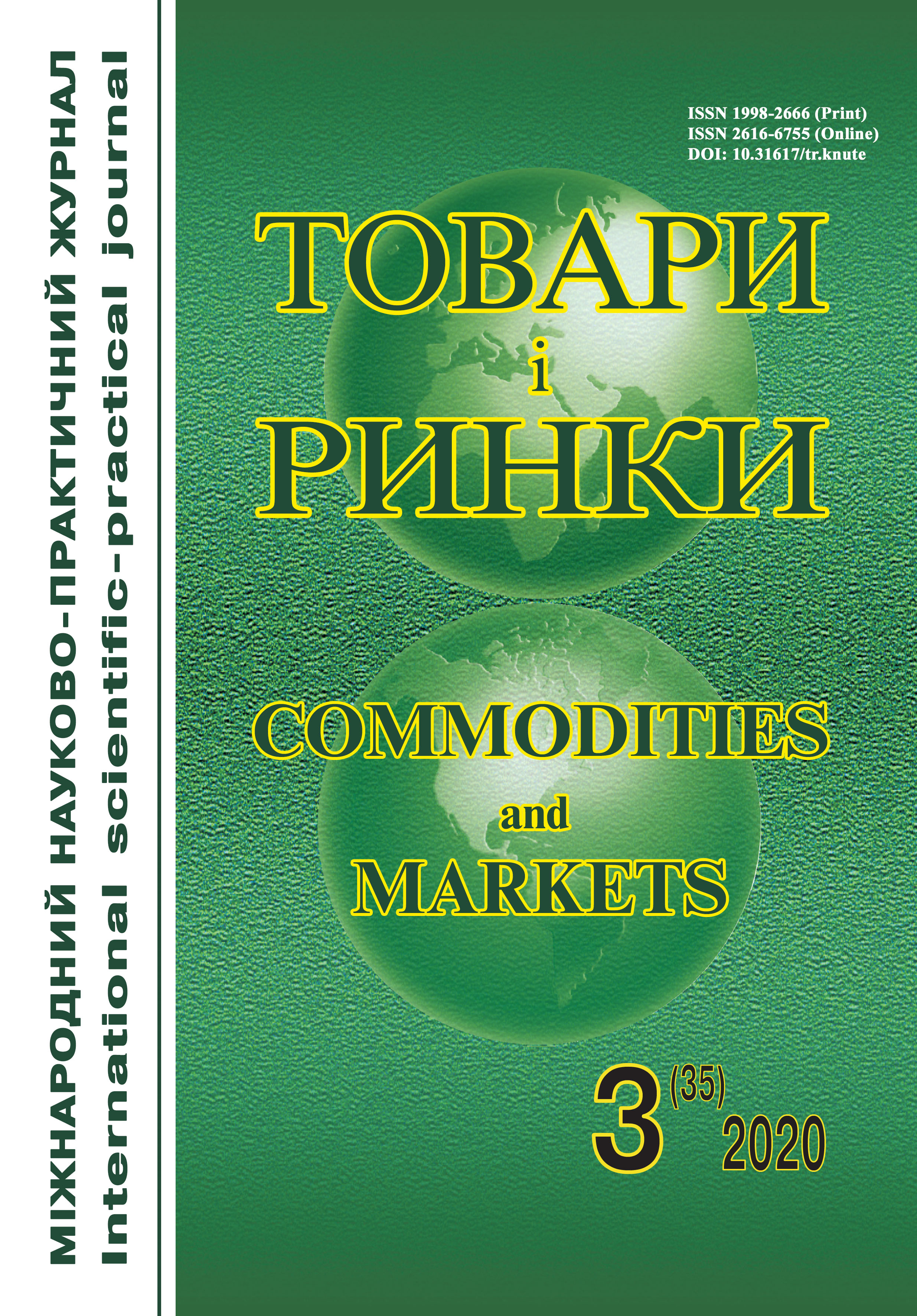Chemical composition of confectionery bean pastes
DOI:
https://doi.org/10.31617/tr.knute.2020(35)10Keywords:
finishing semi-finished products, bean paste, dry demineralized whey, nutritional value, biological value, energy valueAbstract
Background. Supplying consumers with high-quality products of increased nutritional and biological value remains an urgent problem today.
This work aims to study the chemical composition of model compositions of bean pastes with milk dry demineralized whey (MDDW).
Materials and methods. The nutritional and energy value of the model compositions of bean pastes was determined by the calculation method of the actual content’s indicators. The amino acid content was determined on the T 339 analyzer, the vitamin content estimated according to standard methods, and the mineral content determined on the ElvaX-med.
Results confirm the high nutritional value of the developed bean pastes based on MDDW. Protein content 9.8–10.3%. According to the results of the carbohydrate composition analysis, it was noted sucrose content, starch, and dietary fiber decrease, by 1.3–1.5 times compared with the control, and a corresponding content of lactose increases to 10–15 % of the total carbohydrate composition.
The energy value of the developed bean pastes is 1.6 times lower than in the control. The developed bean pastes used as finishing semi-finished products have significant advantages over other plastic confectionery masses. It was found that the energy valueof the developed bean pastes is 2.7 times lower than sugar pastes and 4.1 times lower than marzipan.
The biological value of the proteins in model formulations of bean pastes with MDDW increased by 1.7 times compared to bean pastes made by using traditional techniques.
Significant advantages in terms of the content of minerals in bean pastes with MDDW in comparison with the control were established. The concentration of MDDW in 10-30% allows increasing the K content in bean pastes by 2.5 times, Ca – 7 times, Mg – 3 times,Na – 14 times, P – 3 times, I – 3.5 times. The vitamin composition of bean paste with MDDW is supplemented with vitamins C, B12, B7, B4, the content of B5 increases 3 times, B2 – 4 times.
Conclusion. The developed technology of bean pastes based on MDDW allows producing high-quality low-calorie finishing semi-finished products for confectionery products. Research results confirm their high nutritional and biological value.
It has been experimentally confirmed that MDDW at a concentration of 10–30% in a bean paste formulation can significantly improve the mineral and vitamin composition.
References
Vsemirnaja organizacija zdravoohranenija. (2015). Global’nye faktory riska dlja zdorov’ja: smertnost’ i bremja boleznej, obuslovlennye nekotorymi osnovnymi faktorami riska [World Health Organization. Global health risk factors: mortality and disease burden due to some major risk factors]. VOZ: Zheneva [in Russian].
Dzjuba, O. M., Pazynych, L. M., Sytenko, O. R., & Kryvenko, Je. M. (2017). Shhodo pytannja global’nogo tjagarja hvorob v Ukrai’ni [On the issue of the global burden of disease in Ukraine]. Visnyk social’noi’ gigijeny ta organizacii’ ohorony zdorov’ja Ukrai’ny – Bulletin of social hygiene and health care organization of Ukraine. (Vol. 72), 2, 814-818 [in Ukrainian].
Honda, Y., Saito, Y., Mishima, T., Katsumi, N., Matsumoto, K., Enomoto, T., & Miwa, S. (2020). Characterization of physicochemical and digestive properties of starches from various "dainagon" adzuki beans (Vigna angularis) cultivated in Japan. International Journal of Biological Macromolecules. (Vol. 1), 26, 121-128 [in English].
Li, Z., Rui, J., Li, J., Dong, L., Huang, Q., & Huang C. (2017). Bacterial community succession and metabolite changes during doubanjiang-meju fermentation, a Chinese traditional fermented broad bean (Vicia faba L.) paste. Food Chemistry. (Vol. 1), 218,534-542 [in English].
Rybchuk, L. A. (2020). Perspektyvnist’ vykorystannja bobovyh past u kondyters’komu vyrobnyctvi [Prospects for the use of bean pastes in confectionery production]. Tehnichni nauky ta tehnologii’ – Technical sciences and technologies, 2 (20), 253-263[in Ukrainian].
Gondar, O. P., & Romanchuk, I. O. (2015). Zmina mineral’nogo skladu suhoi’ molochnoi’ syrovatky za riznyh metodiv obroblennja [Changes in the mineral composition of whey powder by different processing methods]. Zbirnyk naukovyh prac’ Vinnyc’kogonacional’nogo agrarnogo universytetutu. Serija: Tehnichni nauky – Collection of scientific works of Vinnytsia National Agrarian University. Series: Technical Sciences, 1 (89), (Vol. 1), (pp. 94-99) [in Ukrainian].
Romanchuk, I. O., Minorova, A. V., & Moisejeva, L. O. (2017). Vyznachennja harchovoi’ cinnosti molochnyh produktiv: suchasni pogljady ta metodychni rekomendacii’ [Determining the nutritional value of dairy products: modern views and guidelines]. Prodovol’chi resursy – Food resources. (pp. 249-254) [in Ukrainian].
Himicheskij sostav rossijskih pishhevyh produktov [The chemical composition of Russian food products]. (2002). I. M. Skurikhin & V. A. Tutelyan (Eds.). Moscow: DeLi print [in Russian].
Method to manufacture adzuki bean paste containing refined soy pulp, and adzuki bean paste and processed food containing refined soy pulp. Retrieved from https://patents.google.com/patent/WO2011039861A1/en [in English].
Ermakov, A. I., Arasimovich, V. V., & Jarosh, N. P. (1987). Metody biohimicheskogo issledovanija rastenij [Biochemical research methods of plants]. A. I. Ermakov (Ed.). (3 nd. ed., rev). Leningrad: Agropromizdat [in Russian].
Harischarishvili, I. Z., & Gorgoshidze, B. E. (2006). Analiz mikrojelementnogo sostava volos rentgenofluorescentnym metodom i ego znachenie v dele diagnostiki zabolevanij cheloveka [Analysis of trace element composition of hair by X-ray fluorescence method and its importance in the diagnosis of human diseases]. Jeksperimental’naja i klinicheskaja medicina – Experimental and Clinical Medicine, 7, 65-67 [in Russian].
Gal’chenko, S. M., Korotkov, P. A., & Kyrylenko, Je. K. (2009). Rentgenofluorescentnyj metod vyznachennja mikroelementnogo skladu pytnoi’ vody [X-ray fluorescence method for determining the trace element composition of drinking water]. Novi tehnologii’– New technologies, 1, 214-221 [in Ukrainian].
Jeksperimental’naja vitaminologija [Experimental Vitaminology]. (1979). Yu. M. Ostrovsky (Ed.). Minsk: Nauka i tehnika [in Russian].
Kravchenko, M. F., & Rybchuk, L. A. (2019). Novi vydy ozdobljuval’nyh kondyters’kyh napivfabrykativ [New types of finishing confectionery semi-finished products]. Praci Tavrijs’kogo derzhavnogo agrotehnologichnogo universytetu – Proceedings of the Tavriya State Agrotechnological University, 3 (19), 255-271 [in Ukrainian].
Kravchenko, M. F., & Rybchuk, L. A. (2019). Optymizacija himichnogo skladu marcypanovyh past [Optimization of the chemical composition of marzipan pastes]. Praci Tavrijs’kogo derzhavnogo agrotehnologichnogo universytetu – Proceedings of the Tavriya State Agrotechnological University, 3 (19), 233-240 [in Ukrainian].



